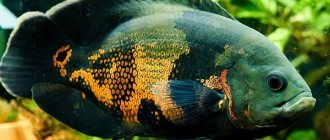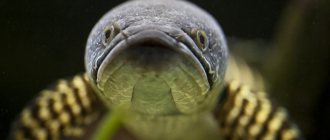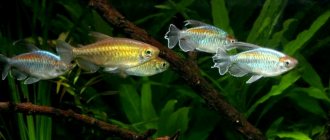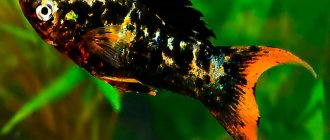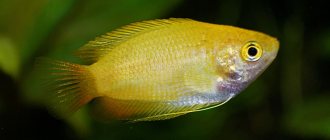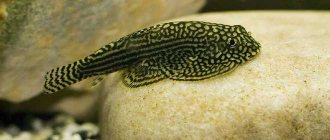What are algae eaters needed for?
These aquarium inhabitants have a special role - to prevent algae from actively developing and to eliminate those types of vegetation that are not visible to our eyes. Algae eater is an aquarium fish that will help you fight excessive greening at the stage of formation of small algae colonies, as well as to clean up their remains after treatment with special means.
This does not mean that aquarium fish (Siamese algae eaters or some other species) can solve absolutely all algae problems. It is advisable to have different types of fish, snails, and shrimp in the aquarium, since each individual species successfully fights certain vegetation. That is why in this article we will talk about different algae eaters. This will allow you to figure out exactly what type is required for your aquarium.
Florida or American Flagfish
A representative of Killie fish, native to swampy Florida, is also able to solve the problem of algae overgrowing in an aquarium. Like livebearers, it is hardy, easy to keep and unpretentious. But the aggressive behavior of male Florida fish significantly limits the possibility of its use.
Amano shrimp
First, we'll talk about Amano shrimp. They got their name in honor of Takashi Amano, who did a lot of work to popularize them. Today their official name is Caridina multidentata, although previously experts believed that this species was called Caridina japonica.
Many aquarists believe that Amano shrimp are a panacea against algae, but this is a misconception. And this type of algae eater (like all others) has preferences for certain plants, and not all of them are to their taste. Amano gives particular preference to filamentous algae. There is one important factor to consider here. The effectiveness of these aquarium cleaners directly depends on the size of the shrimp. The larger they are, the coarser the threads they can absorb.
It is preferable to choose specimens that have reached three, or preferably four, centimeters. Amano shrimp that are too large instantly eat up the cladophora in the aquarium. For an aquarium with a volume of two hundred liters, five pieces of especially large Amano are enough. Individuals measuring 3-4 cm will be required at the rate of 1 piece per 10 liters. These shrimp will be completely useless against xenos and other green algae. In addition, they are less effective against black beard than the Siamese algae-eating fish, which we will talk about later.
Reviews
I believe that Siamese algae eaters are helpers for lazy aquarists. I read about these fish on the forums and decided to try it. They brought minke whales 3-4 cm long. After a 2-week quarantine, they released them into the aquarium. They immediately started eating, as they say, “everything that wasn’t nailed down.” They don't pay attention to other fish. They chase each other, and then lie peacefully. Miracles did not happen, the walls still have to be cleaned, but the aquarium does not become overgrown with vegetation. Ekaterina Nikolaevna, Moscow.
These little fish helped get rid of black beard. I tried many means to remove it. They advised me to buy algae eaters. I got two babies. At first the fish showed no interest in the “flip-flop”. I haven't fed them for 2 weeks. I noticed that then the fish began to eat the “black beard”. At first, hesitantly, and then actively cleared everything from the branches of our favorite crinum, which was dying from the “flip-flops.” Within a month, there was no trace left of the “black beard” in the aquarium. Christmas moss and Cladophora show no interest in moss. Inna R., Kaluga.
I acquired a flock of 4 Siamese algae eaters. I noticed that when I feed the fish, they are not interested in algae. They start eating everything if you don't feed them. While they were small (up to 4 cm), they were not lazy to eat vegetation. When they grow up (7-8 cm), they become “fat” and want to eat ready-made food. Tanya, 38 years old, Engels.
I have a pair of 150 liter SAEs that cope with unwanted vegetation. Occasionally I throw overgrown anubas to the fish for cleaning. Vlad, Tver
I think fish is useless. Algae eaters, while young and nimble, clean up something, but with age they become lazy and accept only ready-made food. OlgaO
Gyrinocheilus (yellow algae eater)
Now let's move on to getting to know the fish of this species. The first one on our list is Gyrinocheilus. This algae-eating fish in the aquarium is the best fighter against the green coating that appears on the walls of containers with high levels of lighting. These include all aquariums (plant-based). Hence, these algae-eating fish are ideal for the herbalist.
Gyrinocheilus has a sucker-shaped mouth, for this reason it feeds only on algae in the form of plaque. Gyrinoheilus does not eat black beard, filamentum and other types of thread-like vegetation. They should be kept at the rate of 1 individual per 40-50 liters, and no more. The fact is that this algae-eating fish feeds only on algae; if you exceed the specified stocking density, you risk killing the fish due to lack of nutrition.
Girinocheilus - the fish are quite active, they are kept in groups with other inhabitants. In an aquarium their size does not exceed 6 cm.
Description
Clean algae eaters are assistants in the aquarium, which in some cases may turn out to be irreplaceable. They, like some types of fish, eat plaque on the soil and leaves of plants inside the aquarium, cleaning and ennobling it. As the name suggests, it is precisely this plant food that is the basis of their diet. In addition, they are good because they destroy types of unfavorable growth that other types of waterfowl do not touch - for example, black beard.
Otocinclus
Another algae-eating fish with a suction cup mouth. The most common is Otocinclus affinis. She also actively fights green plaque and xenococus. It is smaller in size than Gyrinoheilus and is less noticeable in the aquarium. Its length does not exceed 3 cm, which quite often attracts plant lovers in the aquarium.
Its effectiveness against algae is approximately equal to that of the previous representative of algae eaters, but otocinclus is less hardy and very sensitive to the composition of the water. Like most loricariid catfish, otocinclus does not tolerate large amounts of nitrates in water (10-20 mg/l). In this case, he becomes lethargic and may die. These fish should be kept at the rate of no more than one individual per 40-50 liters of water.
Diseases
With proper care, algae eaters in an aquarium rarely get sick. By nature they have good immunity, but if you don’t keep things clean and feed the fish with low-grade food, the body’s protective functions may fail.
Due to the high content of nitrates in water, which are formed during the decomposition of plant and animal residues, fish can be affected by various bacterial and viral infections. If the algae eater's behavior has changed, it is sluggish or, conversely, too active, you need to carefully observe it. Signs of illness may appear in the form of a rash or plaque on the scales, bulging and reddened eyes, and bruises in the area of the operculum.
Often, changing the water and general cleaning of the aquarium normalizes the condition, but if the disease progresses, antibiotics are used.
Although breeding the Siamese algae eater is impossible in a home aquarium, it is always popular. Juveniles of this unsurpassed cleaner can be found in almost any pet store.
Algae eaters are those inhabitants whose presence in the aquarium is mandatory. They are often forgotten and this means that a small amount of algae in an aquarium can lead to a large algae outbreak. The main article about algae in an aquarium already described the reasons for the appearance and methods of combating algae. The main role of algae eaters is to prevent algae from actively developing and to eliminate those algae in the aquarium that are invisible to your eye. This is important at the stage of the appearance of small algae colonies and at the stage of cleaning up algae residues after the treatment procedure with special means. But this does not mean that keeping, for example, only Siamese algae eaters in the aquarium will solve all problems with algae. It is important to have different types of algae eater fish, shrimp or snails in your aquarium because each type of algae eater is only effective against certain algae. Therefore, the main purpose of this article is to characterize the effectiveness of each type of algae eater. In other words, which type of algae eater is effective against which algae.
Mollies
This is a less fastidious algae eater. A fish whose maintenance, according to aquarists, is much simpler. This is explained by the fact that mollies (mollies) eat all varieties of filamentous algae, and black beard, and will not refuse plaque on the walls of the aquarium.
However, their effectiveness is not very high, like that of Girinocheilus or Amano shrimp. Mollies are very often kept in herbal aquariums because they are almost always available in pet stores, which is especially important in cases of algae outbreaks.
Diseases
Siamese algae eaters are resilient fish, undemanding to their living conditions, but sometimes they get sick.
The causes of the disease may be:
- poor quality nutrition (feed selected incorrectly);
- failure to keep the aquarium clean;
- fish incompatibility.
The inhabitants of the aquarium may die from improper maintenance.
Signs of fish disease:
- there is a lot of yellow and white waste in the aquarium;
- presence of visible parasites;
- the formation of white plaque (moss) on the body of fish;
- eyes become cloudy or bulging;
- the appearance of white and black dots on the body;
- ruffled fins and tail;
- unusual behavior, restlessness;
- the fish lose weight or, conversely, the belly swells;
- In some places the scales fall off, red spots (ulcers) are visible.
The occurrence of at least one of the symptoms indicates health problems in the Siamese algae eater.
First you need to check the water in the aquarium for harmful substances.
What makes the Siamese algae eater sick?
SAEs get sick not only because of unsuitable water and improper care. Infections, fungi, and bacteria entering the aquarium can also cause fish illness.
Sick individuals are immediately transplanted into another container. The duration of quarantine for each fish is individual.
Mycobacteriosis
One of the diseases caused by bacteria. The algae eater's eyes bulge out. The fish hides, moves little, and loses weight. The disease is dangerous not only for other inhabitants of the aquarium, but also for humans. SAE is treated with antibiotics, having previously been removed. Often the disease ends in death.
Fungus
The presence of a fungal infection is indicated by the appearance of a white coating on the body of the Siamese algae eater. Old age of fish and stress lead to decreased immunity. A weakened body is susceptible to parasitism by fungi. SAE is treated with special medications purchased at a pet store.
Protozoa infection
Unusual behavior of the fish, when it rubs its body on the stones, and its movements are too impetuous, as well as the presence of mucus, indicate infection with protozoa.
Preventative measures will help avoid infection if you first boil objects immersed in the aquarium. It is necessary to check the health of newly acquired fish and vegetation within half a month by planting separately.
Ancistrus
This algae-eating fish is effective against green plaque only at a young age (up to 4 cm). Usually in an aquarium it grows to a fairly impressive size (15 cm). Therefore, when the choice is between them and Gyrinocheilus or Otocinclus, preference is usually given to the latter.
Meanwhile, ancistrus are very unpretentious and easy to find on sale, so they are quite common in herbal aquariums.
Viviparous fish (viviparous fish)
Hungry Mollies and other viviparous fish can eat almost all types of algae. They are unpretentious and get along with most representatives of other families. The only problem is the high reproduction rate. Thus, having solved one problem, you will have to solve another - where to put a huge number of young fish. True, livebearers themselves can find a solution by eating their own offspring.
Siamese algae eater
Finally, we come to the real aquarium cleaner. This is a Siamese algae-eating fish. The very peaceful and not too large fish comes in two species: the Siamese algae eater and the Siamese flying fox (Epalzeorhynchus sp). The second variety is often called the false algae eater. These fish are very similar in appearance, so they are often confused.
In most cases, real Siamese algae eaters are on sale, but it happens that their false “relatives” are passed off as them. This is not surprising - under natural conditions they live in the same habitat, and the young of these fish often create mixed schools.
Nutrition
It is clear that the main food of the sai is algae, however, if there is a lack of algae, the algae-eater fish willingly eats any food offered to it: dry, frozen, live. The diet must include vegetables: zucchini, cucumber, spinach, lettuce. Before feeding, they must be doused with boiling water. Older fish mainly eat protein foods.
Although these fish are called algae eaters, their diet should also contain other foods.
It is good to clear algae from snags, stones and plants only in the case of a half-starved state; juveniles cope best with this.
How to distinguish the two varieties?
You need to know that in a real algae eater, a horizontal black stripe running throughout the body continues to the caudal fin, while in a chanterelle it does not. This stripe of a real “Siamese” runs in a zigzag manner, its edges are uneven.
The false algae eater has a mouth that resembles a pink ring. A real algae eater has one pair of black whiskers, while a false one has two (almost invisible). Inexperienced aquarists may ask a very reasonable question: “What does it matter whether the representative of the species in front of you is real or false?” The thing is that the fox eats algae much worse, and most importantly, it is aggressive towards its neighbors in the aquarium, therefore it is less suitable for an underwater “hostel”.
Habitat in natural conditions
This fish is found in southeast Asia, Sumatra, Thailand and Indonesia. The Siamese algae eater is found in fast rivers and streams with a hard bottom lined with cobblestones, gravel and sand. Prefers submerged tree roots and a large number of submerged snags.
Transparency and low water levels create favorable conditions for the intensive development of algae, which the algae eater feeds on. Experts believe that this fish can migrate, moving to muddier and deeper waters.
Reproduction and lifespan
The Siamese algae eater does not reproduce in captivity; there is no evidence of successful breeding of this fish in an aquarium. Even compliance with all water parameters, the presence of a current and hormonal stimulation of the female does not guarantee the hatching of fry. Algae eater eggs are very susceptible to fungal infections and in most cases spoil during the ripening process.
All specimens presented in pet stores are either caught from natural reservoirs or obtained on specialized farms in Southeast Asia using strong hormonal drugs. In favorable conditions, aquarium algae eaters can live up to 10 years .
Siamese algae eater fish: keeping in an aquarium
Representatives of this species grow up to 15 cm. Their life expectancy sometimes exceeds 10 years. For maintenance, a volume of 100 liters is recommended. This is one of the most unpretentious inhabitants of the aquarium, adapting well to various conditions.
However, experts believe that it is better to keep them in aquariums that imitate the natural environment of fast rivers. It is advisable to create open places for them to swim and equip the aquarium with driftwood and large stones. The Siamese algae eater likes to rest on wide leaves, so you should purchase several large plants for them.
Water parameters must comply with the following standards:
- pH - 5.5-8.0;
- water temperature - +23-26°C;
- hardness - 5-20 dh.
Siamese algae eaters are good jumpers, so the aquarium needs to be covered or so-called floating plants that cover the surface of the water.
When fully fed, the “Siamese” do not touch the plants, but eat duckweed, as well as the roots of water hyacinth.
Neocaridins
Neocaridins are the most common shrimp among aquarists due to their ease of cultivation. Small shrimp - 1-2 cm, have an effect in the fight against algae, mainly due to their usually large number in the aquarium (one or more shrimp per liter of aquarium). Like Amano shrimp, neocaridins prefer filamentous algae. And due to their small size, they can only handle the softest types of filamentous algae, for example, Rhizoclonium .
These shrimp are indispensable at the stage of starting an aquarium with plants. They actively process rotted leaves of recently planted plants and actively fight against rhizoclonium, which almost always appears in the first month of life of a planted aquarium and can significantly slow down the growth of aquarium plants by completely covering them. In a mature aquarium, neocaridins play a major role in recycling leftover food from rotted leaves, thereby maintaining balance in the aquarium and preventing excessive snail reproduction. These are the best orderlies in a plant aquarium. Read more about neocaridin.
Siamese algae eater: compatibility with other fish
We have already said that this is a peaceful fish, and therefore can be kept with most fish. Living together with veiled forms is not recommended - the Siamese algae eater can bite their fins. Undesirable neighbors include the two-color labeo. This is explained by the fact that these two species are relatives, between which fights will certainly arise.
In addition, this species exhibits territoriality between males, so it is not recommended to keep two in the same aquarium. The Siamese algae eater, as a fairly active fish, will not be a good neighbor to cichlids, which jealously guard their territory during spawning.
Cleaner catfish
The cleaner catfish is a modest and peaceful fish, it is small in size, leads a hidden lifestyle and, most importantly, is able to rid the aquarium of any algae, while leaving the plants intact. It is invisible and copes well with the task for which it is purchased, therefore it is often used in decorative exhibition aquariums. This fish can be called the best algae eater.
